Gemology, Mineralogy, and Spectroscopy of Gem-Quality Diopside from Pakistan and Russia: New Insights for the Chromogenic Mechanism and Possible Origin
(This article belongs to the Section Mineralogical Crystallography and Biomineralization)
Abstract
1. Introduction
2. Geological Setting
3. Materials and Methods
3.1. Samples Description
3.2. Microscopic Analysis and Spectroscopy
3.3. SEM Analyses
3.4. Chemical Analysis
4. Results
4.1. Visual Appearance and Gemological Properties of Diopside
4.2. Spectral Characteristics
4.2.1. FTIR Spectrum
4.2.2. Raman Spectra
4.2.3. UV-Visible Spectra
4.3. Major and Trace Elements Characteristics of Diopside
5. Discussion
5.1. Gemological Characteristics
5.2. Chromogenic Mechanism of Different Diopsides
5.3. Origin of Different Diopsides: Elemental Constraints
6. Conclusions
Author Contributions
Funding
Data Availability Statement
Acknowledgments
Conflicts of Interest
References
- Cameron, M.; Sueno, S.; Prewitt, C.T.; Papike, J.J. High-temperature crystal chemistry of acmite, diopside, hedenbergite jadeite, spodumene and ureyite. Am. Mineral. J. Earth Planet. Mater. 1973, 58, 594–618. [Google Scholar]
- Putnis, A. An Introduction to Mineral Science; Cambridge University Press: Cambridge, UK, 1992. [Google Scholar]
- Titorenkova, R.; Kostov-Kytin, V.; Dimitrov, T. Synthesis, phase composition and characterization of Co-diopside ceramic pigments. Ceram. Int. 2022, 48, 36781–36788. [Google Scholar] [CrossRef]
- Akasaka, M.; Takasu, Y.; Handa, M.; Nagashima, M.; Hamada, M.; Ejima, T. Distribution of Cr3+ between octahedral and tetrahedral sites in synthetic blue and green (CaMgSi2O6)95(CaCrAlSiO6)5 diopsides. Mineral. Mag. 2019, 83, 497–505. [Google Scholar] [CrossRef]
- Mantovani, L.; Tribaudino, M.; Bertoni, G.; Salviati, G.; Bromiley, G. Solid solutions and phase transitions in (Ca, M2+)M2+Si2O6 pyroxenes (M2+ = Co, Fe, Mg). Am. Mineral. 2014, 99, 704–711. [Google Scholar] [CrossRef]
- White, W.B.; Mccarthy, G.J.; Scheetz, B.E. Optical spectra of chromium, nickel, and cobalt-containing pyroxenes. Am. Mineral. J. Earth Planet. Mater. 1971, 56, 72–89. [Google Scholar]
- Mottana, A.; Rossi, G.; Kracher, A.; Kurat, G. Violan revisited: Mn-bearing omphacite and diopside. TMPM Tschermaks Mineral. Petrogr. Mitt. 1979, 26, 187–201. [Google Scholar] [CrossRef]
- Griffin, W.L.; Mottana, A. Crystal chemistry of clinopyroxenes from the St. Marcel manganese deposit, Vald’Aosta, Italy. Am. Mineral. 1982, 67, 568–586. [Google Scholar]
- Lin, C.Y.; Zhu, H.B.; Wang, Z.M.; Xie, H.S.; Zhang, Y.M.; Xu, H.G. Optical absorption spectra and colors of jadeites and diopsides. Acta Mineral. Sin. 1988, 3, 193–199, (In Chinese with English Abstract). [Google Scholar]
- Yuan, Y.M.; Qiu, X.J. Optical absorption spectra of diopside. Acta Mineral. Sini. 1985, 2, 157–184, (In Chinese with English Abstract). [Google Scholar]
- Cara, W.; Laurs, B.M. Blue diopside from Russia. J. Gemmol. 2020, 37, 124–126. [Google Scholar]
- Korchagin, A.M. Inagli Pluton and Its Mineral Resources; Nedra: Moscow, Russia, 1996; Volume 157. (In Russian) [Google Scholar]
- Naumov, V.; Kamenetsky, V.; Thomas, R. A record of alkali silicate-sulphate melts trapped as inclusions in chromium diopside (Inagty deposit, Yakutia, Russia). In Proceedings of the Program with Abstracts of the First Meeting Asia Current Research on Fluid Inclusion, Asian Current Research on Fluid Inclusions I, Nanjing, China, 26–28 May 2006. [Google Scholar]
- Okrugin, A.V.; Borisenko, A.S.; Zhuravlev, A.I.; Travin, A.V. Mineralogical, geochemical, and age characteristics of the rocks of the Inagli dunite–clinopyroxenite–shonkinite massif with platinum–chromite and Cr-diopside mineralization (Aldan Shield). Russ. Geol. Geophys. 2018, 59, 1301–1317. [Google Scholar] [CrossRef]
- Khlif, N.; Vishnevskiy, A.; Izokh, A.; Chervyakovskaya, M. Mineral Chemistry and Trace Element Composition of Clinopyroxenes from the Middle Cambrian Ust’-Sema Formation Ankaramites and Diopside Porphyry Basalts and the Related Barangol Complex Intrusions, Gorny Altai, Russia. Minerals 2022, 12, 113. [Google Scholar] [CrossRef]
- Diella, V.; Bocchio, R.; Caucia, F.; Marinoni, N.; Langone, A.; Possenti, E. New insights for gem-quality Mn-bearing diopside-omphacite, violane variety, from Saint Marcel (Val D’Aosta, Italy): Its trace elements and spectroscopic characterization. Minerals 2021, 11, 171. [Google Scholar] [CrossRef]
- Le Fort, P.; Pecher, A. An Introduction to the geological Map of the Area between Hunza and Baltistan, Karakorum–Kohistan–Ladakh–Himalaya Region, Northern Pakistan (Scale 1:150,000). Geologica 2002, 6, 1–140. [Google Scholar]
- Agheem, M.H.; Shah, M.T.; Khan, T.; Murata, M.; Dars, H.; Zafar, M. Petrogenetic evolution of pegmatites of the Shigar valley, Skardu, Gilgit–Baltistan, Pakistan. Arab. J. Geosci. 2015, 8, 9877–9886. [Google Scholar] [CrossRef]
- Gansser, A. Geology of the Himalayas; John Wiley: New York, NY, USA, 1964; 289p. [Google Scholar]
- Rolland, Y.; Pecher, A.; Picard, C. Middle Cretaceous back-arc formation and arc evolution along the Asian margin: The Shyok Suture Zone in northern Ladakh (NW Himalaya). Tectonophysics 2000, 325, 145–173. [Google Scholar] [CrossRef]
- Hussain, A.; Shah, M.T.; Arif, M.; Agheem, M.H.; Mughal, M.S.; Ullah, S.; Hussain, S.A.; Sadiq, I. Chemical composition of gemstones and characterization of their host pegmatites and country rocks from Chumar Bakhoor, Gilgit-Baltistan, Pakistan: Implications for the source of gem-forming fluids. Arab. J. Geosci. 2021, 14, 1303. [Google Scholar] [CrossRef]
- Hassan, M. Mineralogy and Geochemistry of the Gemstones and Gemstone-Bearing Pegmatites in Shigar Valley of Skardu, Northern Areas of Pakistan. Ph.D. Thesis, University of Peshawar, Peshawar, Pakistan, 2007; 384p. [Google Scholar]
- Agheem, M.H.; Shah, M.T.; Khan, T.; Laghari, A.; Dars, H. Field features and petrography used as indicators for the classification of Shigar valley pegmatites, Gilgit–Baltistan region of Pakistan. Himal. J. Earth Sci. Univ. Peshawar 2011, 44, 1–7. [Google Scholar]
- Lu, P.R.; Yao, W.G.; Zhang, H.D.; Yu, X.L.; Yang, B.; Meng, G.; Tian, H.P. Nd Isotopic Compositions of the Diorites from Typical Deposits in Reko Dig Porphyry Cu-Au-Ore-Concentrated Area, Pakistan and Their Tracer Significances. Acta Geol. Sin. 2016, 90, 2803–2817. [Google Scholar]
- Blauwet, D.; Smith, B.; Smith, C. A guide to the mineral localities of the Northern Areas, Pakistan. Mineral. Rec. 1997, 28, 183. [Google Scholar]
- Seong, Y.B.; Bishop, M.P.; Bush, A.; Clendon, P.; Copland, L.; Finkel, R.C.; Kamp, U.; Owen, L.A.; Shroder, J.F. Landforms and landscape evolution in the Skardu, Shigar and Braldu valleys, central Karakoram. Geomorphology 2009, 103, 251–267. [Google Scholar] [CrossRef]
- Agheem, M.H.; Shah, M.T.; Khan, T.; Murata, M.; Arif, M.; Dars, H. Shigar valley gemstones, their chemical composition and origin, Skardu, Gilgit–Baltistan, Pakistan. Arab. J. Geosci. 2014, 7, 3801–3814. [Google Scholar] [CrossRef]
- Oktyabr’skii, R.A.; Korchagin, A.M. ‘Siberian Emerald’ (History of Discovery and New Data). Vestn. Dal’nevost. Otd. Ross. Akad. Nauk 2000, 4, 29–36. [Google Scholar]
- Naumov, V.B.; Kamenetsky, V.S.; Thomas, R.; Kononkova, N.N.; Ryzhenko, B.N. Inclusions of silicate and sulfate melts in chrome diposide from the Inagli deposit, Yakutia, Russia. Geochem. Int. 2008, 46, 554–564. [Google Scholar] [CrossRef]
- Naumov, V.B.; Tolstykh, M.L.; Grib, E.N.; Leonov, V.L.; Kononkova, N.N. Chemical composition, volatile components, and trace elements in melts of the Karymskii volcanic center, Kamchatka, and Golovnina volcano, Kunashir Island: Evidence from inclusions in minerals. Petrology 2008, 16, 1–18. [Google Scholar] [CrossRef]
- Chayka, I.F.; Sobolev, A.V.; Izokh, A.E.; Batanova, V.G.; Batanova, S.P.; Chervyakovskaya, M.V.; Kontonikas-Charos, A.; Kutyrev, A.V.; Lobastov, B.M.; Chervyakovskiy, V.S. Fingerprints of Kamafugite-like magmas in Mesozoic lamproites of the Aldan Shield: Evidence from olivine and olivine-hosted inclusions. Minerals 2020, 10, 337. [Google Scholar] [CrossRef]
- Trunilina, V.A.; Prokopiev, A.V. Ore-Bearing Magmatic Systems with Complex Sn–Au–Ag Mineralization in the North-Eastern Verkhoyansk–Kolyma Orogenic Belt, Russia. Minerals 2021, 11, 266. [Google Scholar] [CrossRef]
- Patskevich, G.P. The Inagli deposit of jewelry Cr-diopside. In Gems and Colored Stones [in Russian]; Nauka: Moscow, Russia, 1980; pp. 146–157. [Google Scholar]
- Wang, X.; Hou, T.; Wang, M.; Zhang, C.; Zhang, Z.C.; Pan, R.H.; Marxer, F.; Zhang, H.L. A new clinopyroxene thermobarometer for mafic to intermediate magmatic systems. Eur. J. Mineral. 2021, 33, 621–637. [Google Scholar] [CrossRef]
- Xu, B.; Hou, Z.Q.; Griffin, W.L.; Lu, Y.J.; Belousova, E.; Xu, J.F.; O’Reilly, S.Y. Recycled volatiles determine fertility of porphyry deposits in collisional settings. Am. Mineral. 2021, 106, 656–661. [Google Scholar] [CrossRef]
- Xu, B.; Hou, Z.Q.; Griffin, W.L.; Yu, J.X.; Long, T.; Zhao, Y.; Wang, T.; Fu, B.; Belousova, E.; O’Reilly, S.Y. Apatite halogens and Sr–O and zircon Hf–O isotopes: Recycled volatiles in Jurassic porphyry ore systems in southern Tibet. Chem. Geol. 2022, 605, 120924. [Google Scholar] [CrossRef]
- Xu, B.; Hou, Z.Q.; Griffin, W.L.; Zheng, Y.C.; Wang, T.; Guo, Z.; Hou, J.; Santosh, M.; O’Reilly, S.Y. Cenozoic lithospheric architecture and metallogenesis in Southeastern Tibet. Earth Sci. Rev. 2021, 214, 103472. [Google Scholar] [CrossRef]
- Omori, K. Analysis of the infrared absorption spectrum of diopside. Am. Mineral. J. Earth Planet. Mater. 1971, 56, 1607–1616. [Google Scholar]
- Schreiber, H.D. On the nature of synthetic blue diopside crystals; the stabilization of tetravalent chromium. Am. Mineral. 1977, 62, 522–527. [Google Scholar]
- Schmetzer, K. Absorptionsspektroskopie und Farbe von V3+–haltigen natürlichen Oxiden und Silikaten–ein Beitrag zur Kristallchemie des Vanadiums. Neues Jahrb. Mineral. Abh. 1982, 144, 73–106. [Google Scholar]
- Rossman, G.R. Pyroxene spectroscopy. Mineral. Soc. Am. 1980, 7, 93–115. [Google Scholar]
- Klima, R.L.; Dyar, M.D.; Pieters, C.M. Pieters C M. Near-infrared spectra of clinopyroxenes: Effects of calcium content and crystal structure. Meteorit. Planet. Sci. 2011, 46, 379–395. [Google Scholar] [CrossRef]
- McMillan, P. Structural studies of silicate glasses and melts-applications and limitations of Raman spectroscopy. Am. Mineral. 1984, 69, 622–644. [Google Scholar]
- Mernagh, T.P.; Hoatson, D.M. Raman spectroscopic study of pyroxene structures from the Munni Munni layered intrusion, Western Australia. J. Raman Spectrosc. 1997, 28, 647–658. [Google Scholar] [CrossRef]
- Huang, E.; Chen, C.H.; Huang, T.; Lin, E.H.; Xu, J.A. Raman spectroscopic characteristics of Mg–Fe–Ca pyroxenes. Am. Mineral. 2000, 85, 473–479. [Google Scholar] [CrossRef]
- Katerinopoulou, A.; Musso, M.; Amthauer, G. A Raman spectroscopic study of the phase transition in omphacite. Vib. Spectrosc. 2008, 48, 163–167. [Google Scholar] [CrossRef]
- Buzatu, A.; Buzgar, N. The Raman study of single-chain silicates. An. Stiintifice Univ. AI Cuza Din Iasi. Sect. 2 Geol. 2010, 56, 107. [Google Scholar]
- Chopelas, A. Estimates of mantle relevant Clapeyron slopes in the MgSiO3 system from high-pressure spectroscopic data. Am. Mineral. 1999, 84, 233–244. [Google Scholar] [CrossRef]
- Taran, M.N.; Ohashi, H.; Langer, K.; Vishnevskyy, A.A. High-pressure electronic absorption spectroscopy of natural and synthetic Cr3+-bearing clinopyroxenes. Phys. Chem. Miner. 2011, 38, 345–356. [Google Scholar] [CrossRef]
- Morimoto, N.; Fabries, J.; Ferguson, A.K.; Ginzburg, I.V.; Ross, M.; Seifert, F.A.; Zussman, J.; Aoki, K.; Gottardi, G. Nomenclature of pyroxenes. Am. Mineral. 1988, 73, 1123–1133. [Google Scholar]
- Foley, S.F.; Jackson, S.E.; Fryer, B.J.; Greenouch, J.D.; Jenner, G.A. Trace element partition coefficients for clinopyroxene and phlogopite in an alkaline lamprophyre from Newfoundland by LAM-ICP-MS. Geochim. Cosmochim. Acta 1996, 60, 629–638. [Google Scholar] [CrossRef]
- Abedini, A.; Azizi, M.R.; Dill, H.G. The tetrad effect in REE distribution patterns: A quantitative approach to genetic issues of argillic and propylitic alteration zones of epithermal Cu-Pb-Fe deposits related to andesitic magmatism (Khan Kandi District, NW Iran). J. Geochem. Explor. 2020, 212, 106516. [Google Scholar] [CrossRef]
- Ubide, T.; Kamber, B.S. Volcanic crystals as time capsules of eruption history. Nat. Commun. 2018, 9, 326. [Google Scholar] [CrossRef]
- Nimis, P. A clinopyroxene geobarometer for basaltic systems based on crystal-structure modeling. Contrib. Mineral. Petrol. 1995, 121, 115–125. [Google Scholar] [CrossRef]
- Putirka, K.D.; Johnson, M.; Kinzler, R.; Longhi, J.; Walker, D. Thermobarometry of mafic igneous rocks based on clinopyroxene-liquid equilibria, 0–30 kbar. Contrib. Mineral. Petrol. 1996, 123, 92–108. [Google Scholar] [CrossRef]
- Ravna, K. The garnet–clinopyroxene Fe2+–Mg geothermometer: An updated calibration. J. Metamorph. Geol. 2000, 18, 211–219. [Google Scholar] [CrossRef]
- Nakamura, D. A new formulation of garnet–clinopyroxene geothermometer based on accumulation and statistical analysis of a large experimental data set. J. Metamorph. Geol. 2009, 27, 495–508. [Google Scholar] [CrossRef]
- Villaseca, C.; Dorado, O.; Orejana, D. Mineral chemistry of megacrysts and associated clinopyroxenite enclaves in the Calatrava volcanic field: Crystallization processes in mantle magma chambers. Iber. Geol. 2019, 45, 401–426. [Google Scholar] [CrossRef]
- Villaseca, C.; García Serrano, J.; Orejana, D. Pyroxenites and Megacrysts from Alkaline Melts of the Calatrava Volcanic Field (Central Spain): Inferences from Trace Element Geochemistry and Sr–Nd Isotope Composition. Front. Earth Sci. 2020, 8, 132. [Google Scholar] [CrossRef]
- Frey, F.A.; Green, D.H.; Roy, S.D. Integrated models of basalt petrogenesis: A study of quartz tholeiites to olivine melilitites from South Eastern Australia utilizing geochemical and experimental petrological data. J. Petrol. 1978, 19, 463–513. [Google Scholar] [CrossRef]
- Conor, C.; Raymond, O.; Baker, T.; Teale, G.; Say, P.; Lowe, G. Alteration and mineralisation in the Moonta–Wallaroo copper–gold mining field region, Olympic Domain, South Australia. Hydrothermal Iron Oxide Copp.-Gold Relat. Depos. Glob. Perspect. 2010, 3, 1–24. [Google Scholar]
- Gaspar, M.; Knaack, C.; Meinert, L.D.; Moretti, R. REE in skarn systems: A LA-ICP-MS study of garnets from the Crown Jewel gold deposit. Geochim. Cosmochim. Acta 2008, 72, 185–205. [Google Scholar] [CrossRef]
- Smith, M.P.; Henderson, P.; Jeffries, T.E.R.; Long, J.; Williams, C.T. The rare earth elements and uranium in garnets from the Beinn an Dubhaich Aureole, Skye, Scotland, UK: Constraints on processes in a dynamic hydrothermal system. J. Petrol. 2004, 45, 457–484. [Google Scholar] [CrossRef]
- Bea, F. Residence of REE, Y, Th and U in granites and crustal protoliths; implications for the chemistry of crustal melts. J. Petrol. 1996, 37, 521–552. [Google Scholar] [CrossRef]
- Ismail, R.; Ciobanu, C.L.; Cook, N.J.; Teale, G.S.; Giles, D.; Schmidt Mumm, A.; Wade, B. Rare earths and other trace elements in minerals from skarn assemblages, Hillside iron oxide–copper–gold deposit, Yorke Peninsula, South Australia. Lithos 2014, 184, 456–477. [Google Scholar] [CrossRef]

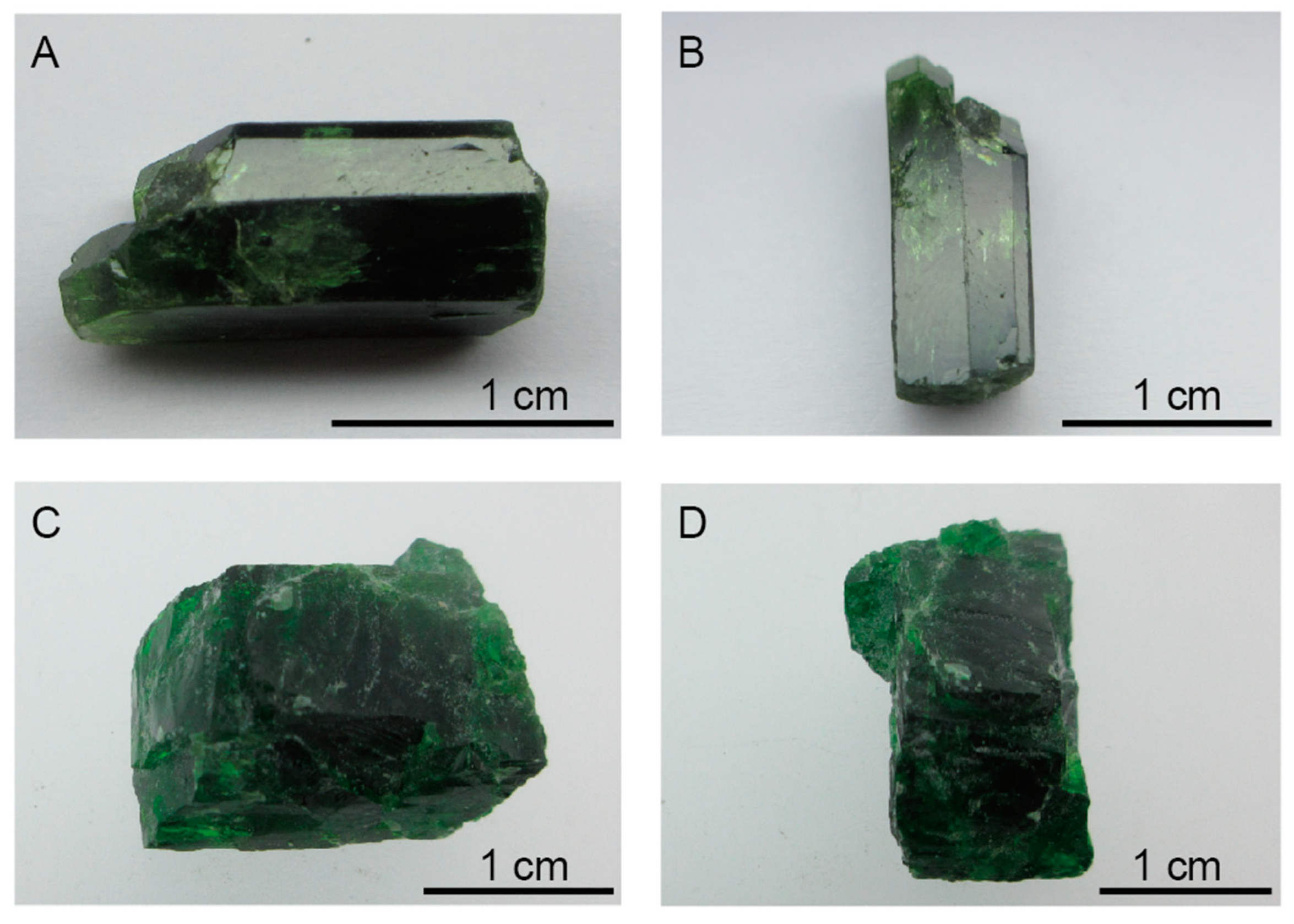
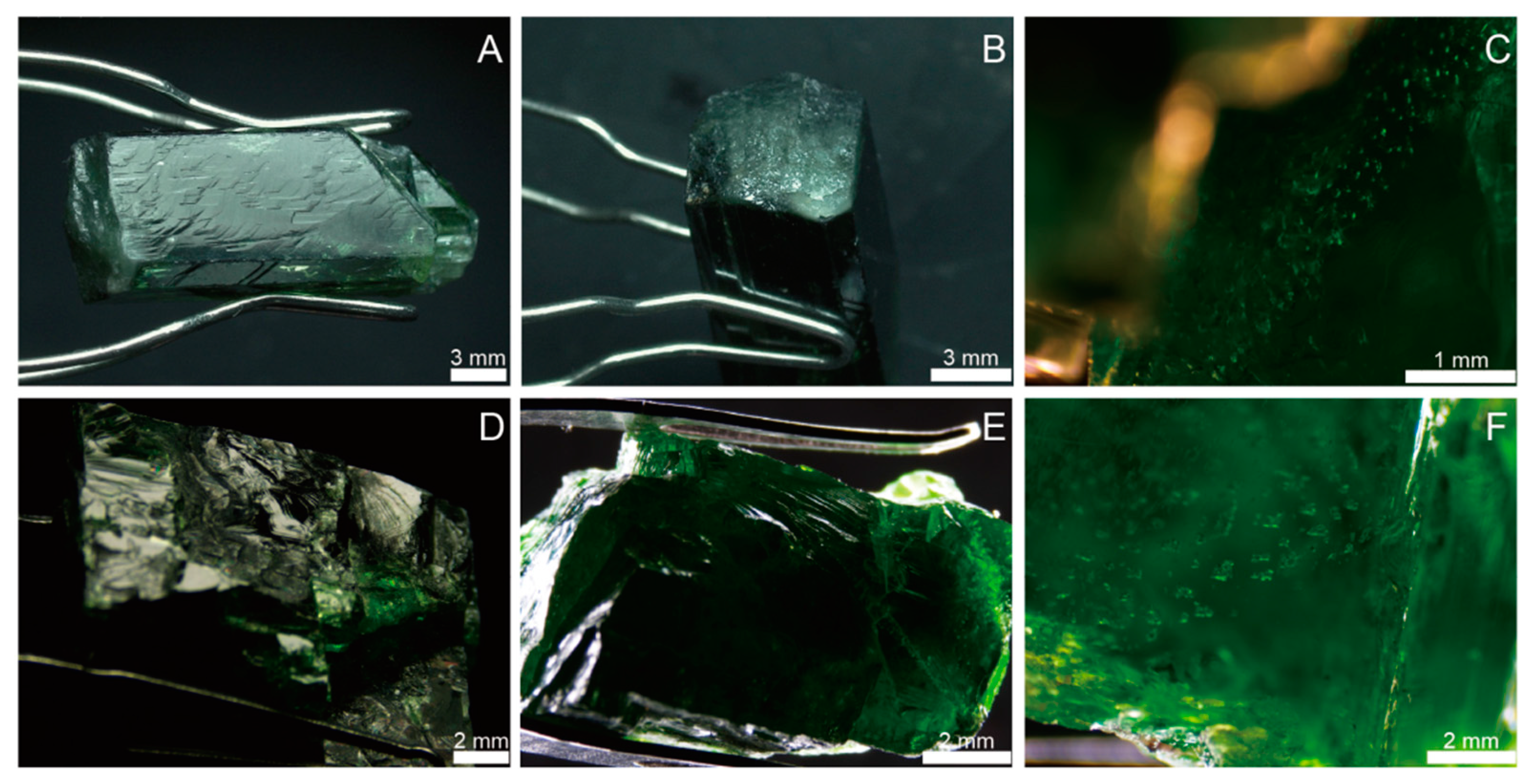
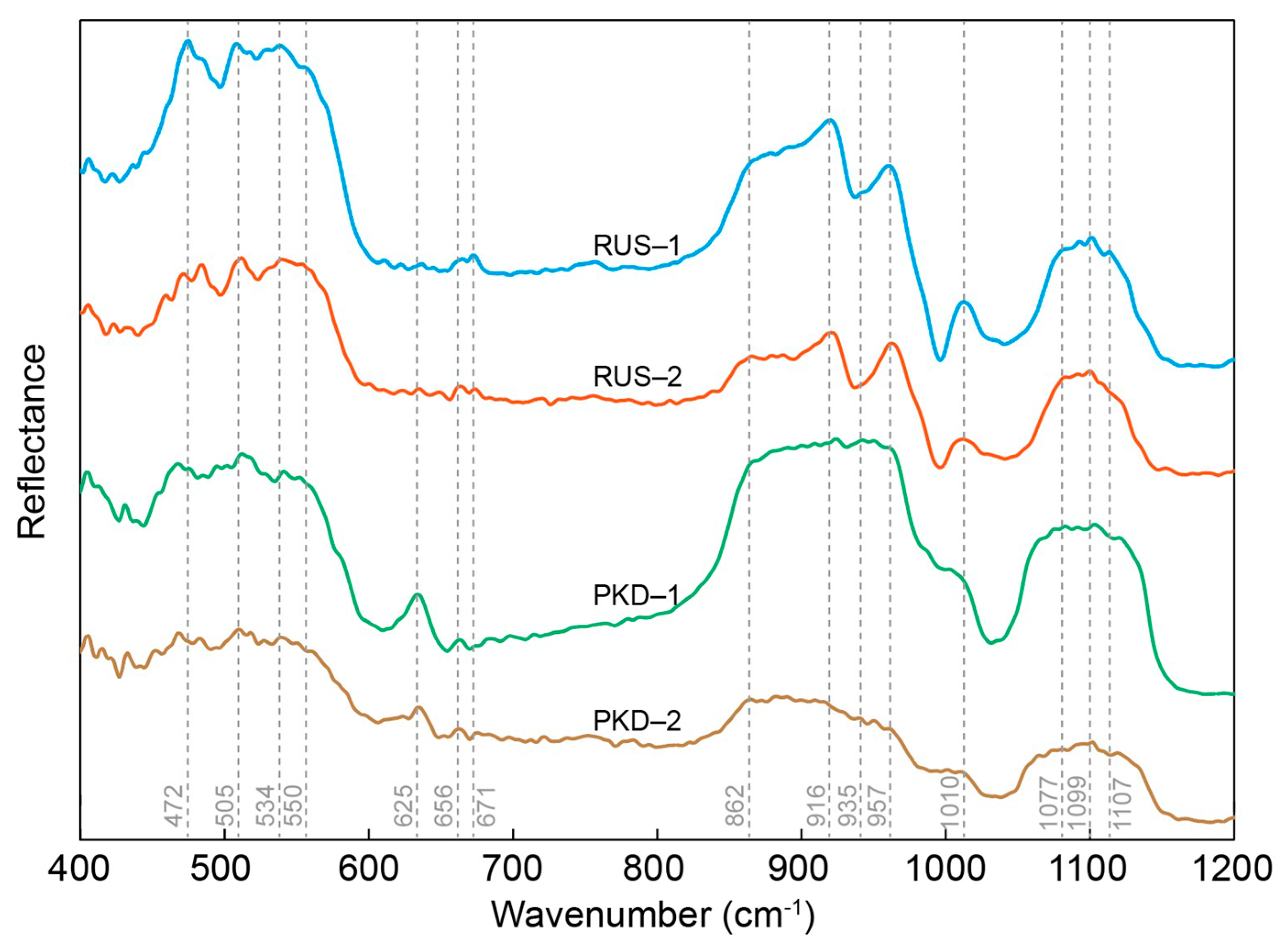

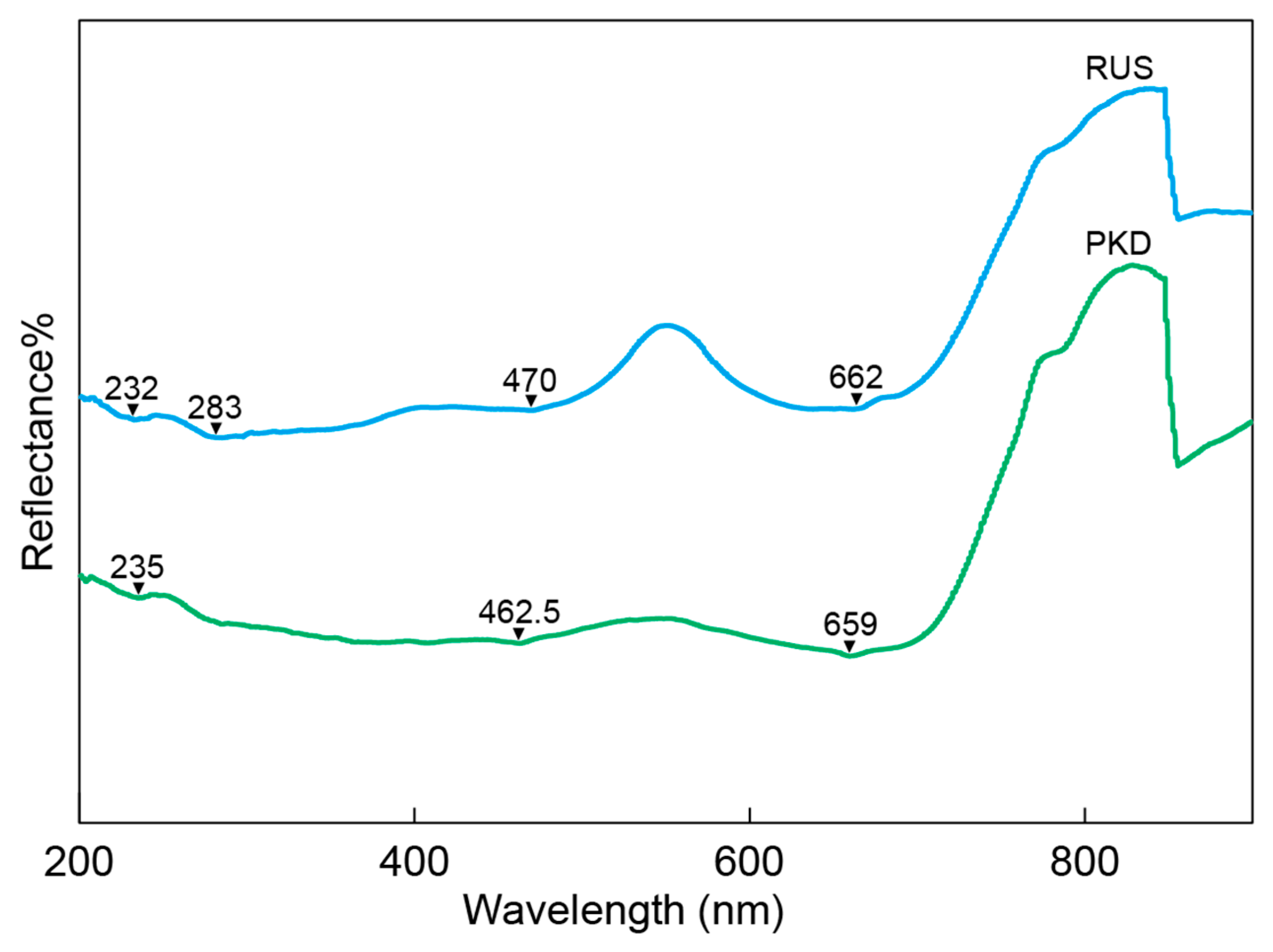
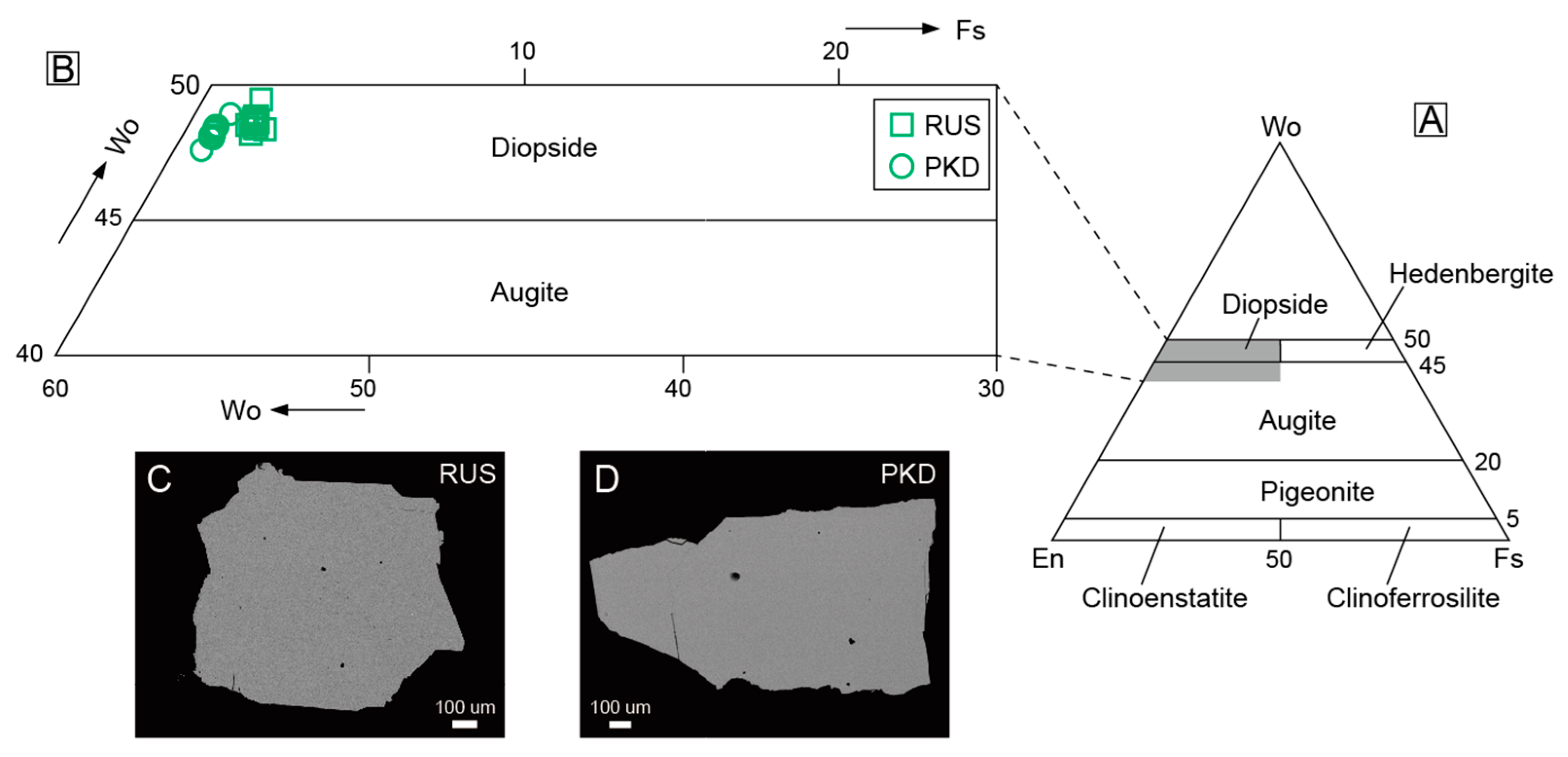
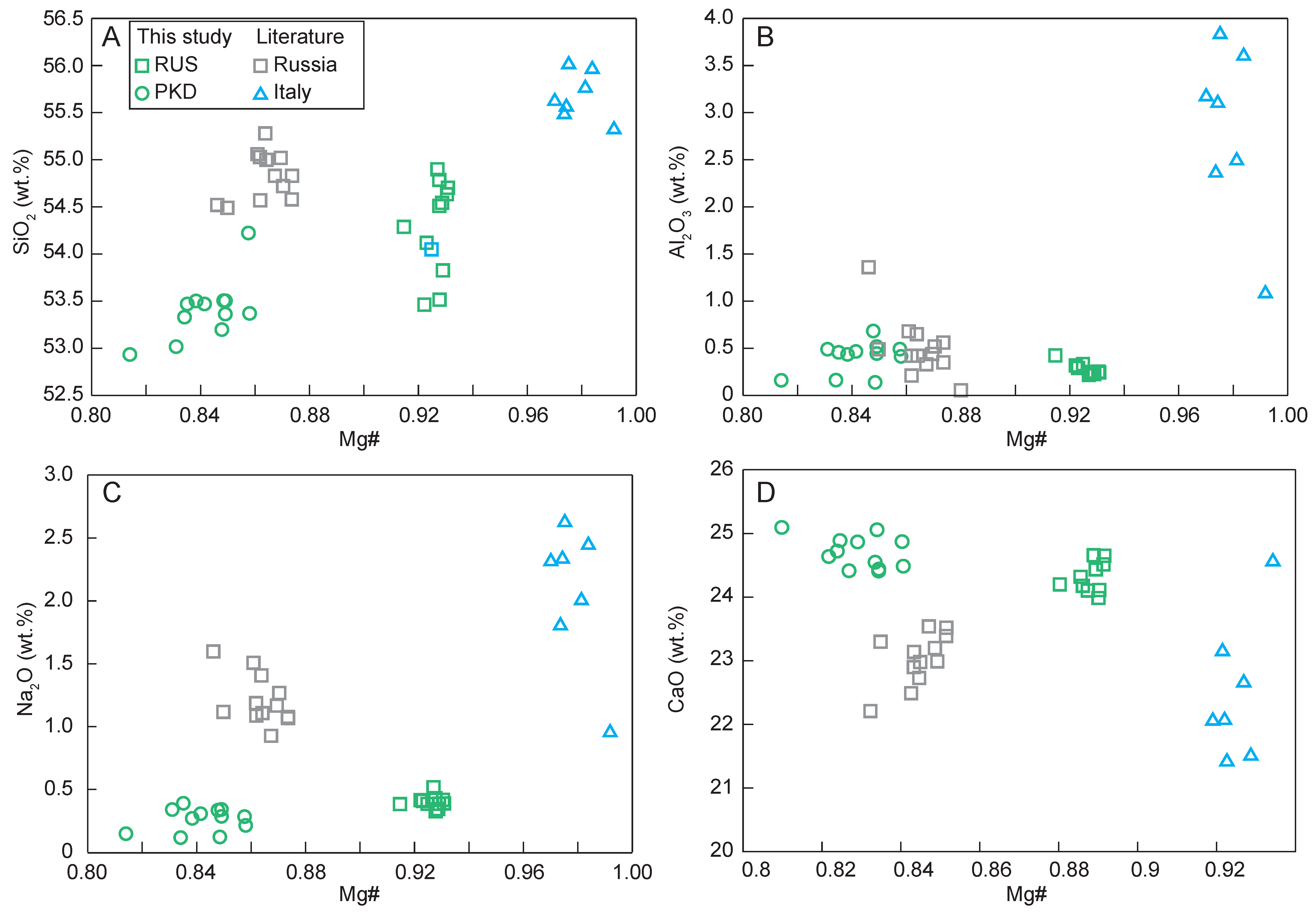
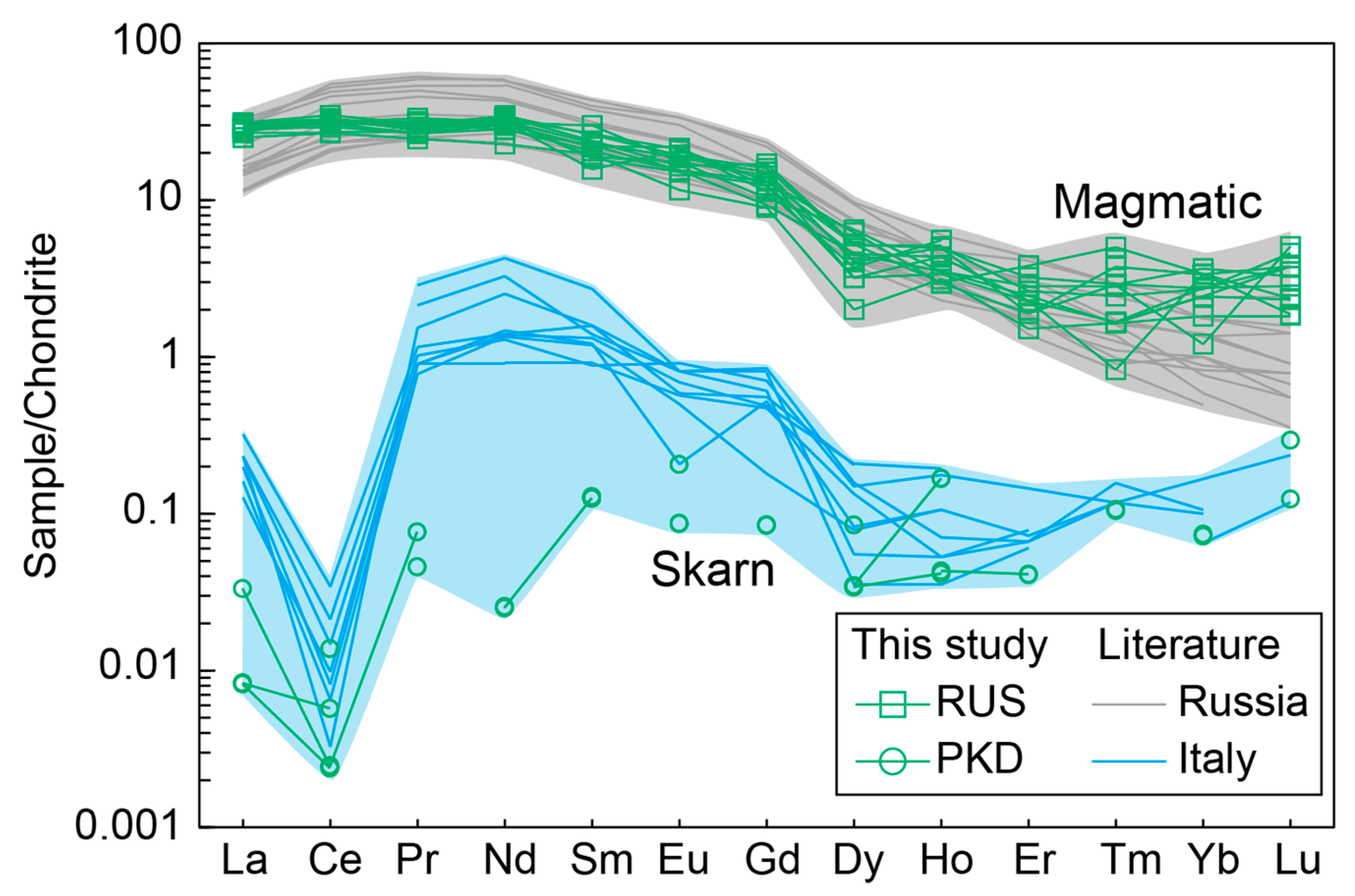
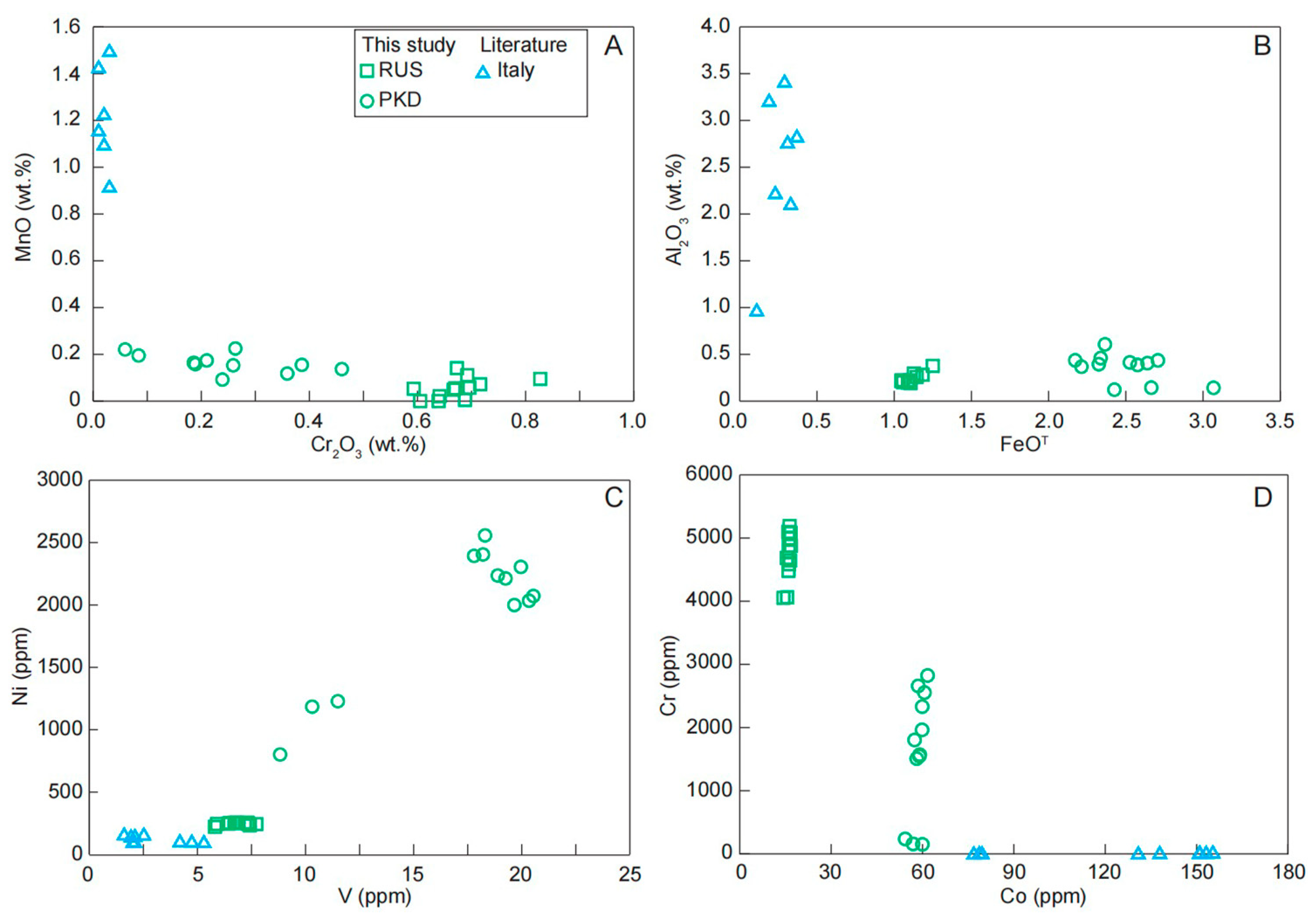

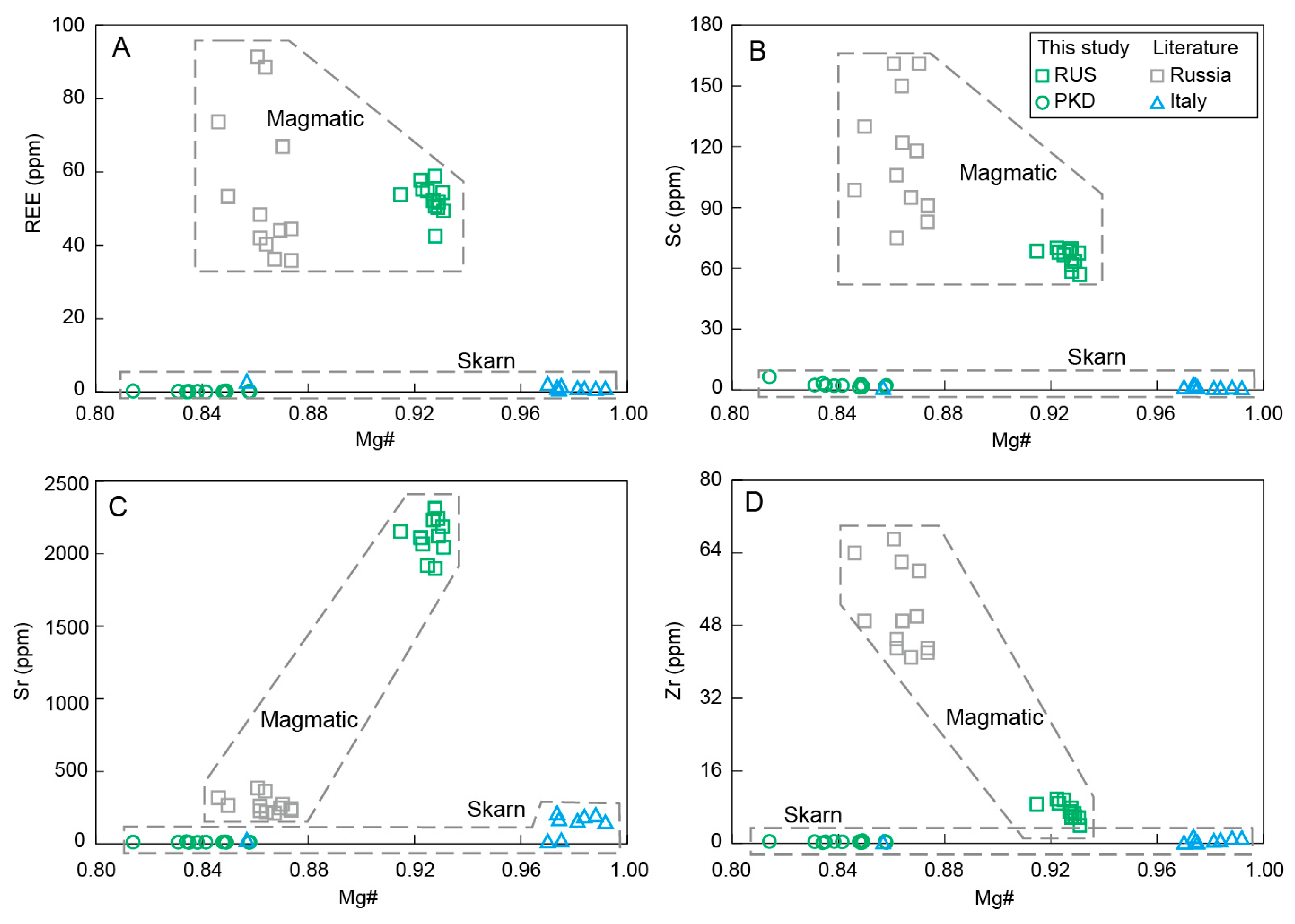

| Sample Spots | SiO2 | TiO2 | Al2O3 | FeO | MnO | MgO | CaO | Na2O | K2O | Cr2O3 | NiO | Total | ||||||
| RUS-01 | 54.29 | 0.06 | 0.42 | 1.25 | 0.14 | 17.37 | 24.20 | 0.39 | 0.03 | 0.67 | 0.06 | 98.88 | ||||||
| RUS-02 | 54.12 | 0.17 | 0.29 | 1.15 | 0.02 | 17.81 | 24.18 | 0.41 | 0.01 | 0.64 | 0.04 | 98.84 | ||||||
| RUS-03 | 54.70 | 0.16 | 0.24 | 1.05 | 0.05 | 18.25 | 24.65 | 0.39 | 0.01 | 0.59 | 0.09 | 100.19 | ||||||
| RUS-04 | 54.63 | 0.09 | 0.25 | 1.05 | 0.07 | 18.19 | 24.52 | 0.42 | 0.02 | 0.72 | 0.02 | 99.98 | ||||||
| RUS-05 | 54.90 | 0.04 | 0.22 | 1.11 | 0.00 | 18.20 | 24.66 | 0.52 | 0.04 | 0.64 | 0.06 | 100.37 | ||||||
| RUS-06 | 54.79 | 0.08 | 0.23 | 1.10 | 0.01 | 18.30 | 24.44 | 0.44 | 0.02 | 0.69 | 0.00 | 100.09 | ||||||
| RUS-07 | 54.51 | 0.16 | 0.24 | 1.09 | 0.06 | 18.10 | 24.44 | 0.42 | 0.01 | 0.70 | 0.10 | 99.82 | ||||||
| RUS-08 | 54.54 | 0.07 | 0.23 | 1.06 | 0.06 | 17.85 | 23.99 | 0.35 | 0.01 | 0.67 | 0.11 | 98.92 | ||||||
| RUS-09 | 53.52 | 0.07 | 0.25 | 1.10 | 0.05 | 18.33 | 24.44 | 0.33 | 0.02 | 0.67 | 0.09 | 98.85 | ||||||
| RUS-10 | 53.83 | 0.09 | 0.23 | 1.09 | 0.00 | 18.47 | 24.11 | 0.39 | 0.01 | 0.61 | 0.07 | 98.88 | ||||||
| RUS-11 | 54.05 | 0.16 | 0.33 | 1.13 | 0.11 | 17.97 | 24.10 | 0.39 | 0.02 | 0.69 | 0.02 | 98.97 | ||||||
| RUS-12 | 53.46 | 0.07 | 0.32 | 1.18 | 0.10 | 18.19 | 24.32 | 0.42 | 0.03 | 0.83 | 0.00 | 98.93 | ||||||
| PKD-01 | 54.22 | 0.00 | 0.49 | 2.17 | 0.16 | 16.95 | 24.87 | 0.29 | 0.00 | 0.39 | 0.24 | 99.78 | ||||||
| PKD-02 | 53.36 | 0.00 | 0.52 | 2.34 | 0.14 | 17.05 | 24.41 | 0.35 | 0.01 | 0.46 | 0.29 | 98.91 | ||||||
| PKD-03 | 53.37 | 0.00 | 0.41 | 2.21 | 0.16 | 17.33 | 24.49 | 0.22 | 0.01 | 0.19 | 0.24 | 98.63 | ||||||
| PKD-04 | 53.50 | 0.00 | 0.44 | 2.33 | 0.23 | 16.96 | 24.44 | 0.29 | 0.00 | 0.26 | 0.24 | 98.70 | ||||||
| PKD-05 | 53.50 | 0.02 | 0.44 | 2.58 | 0.17 | 17.32 | 24.42 | 0.27 | 0.01 | 0.21 | 0.27 | 99.20 | ||||||
| PKD-06 | 53.47 | 0.03 | 0.47 | 2.53 | 0.09 | 17.38 | 24.87 | 0.31 | 0.00 | 0.24 | 0.09 | 99.47 | ||||||
| PKD-07 | 53.02 | 0.00 | 0.49 | 2.71 | 0.16 | 17.26 | 24.64 | 0.34 | 0.00 | 0.19 | 0.21 | 99.02 | ||||||
| PKD-08 | 53.47 | 0.00 | 0.46 | 2.64 | 0.15 | 17.33 | 24.89 | 0.39 | 0.03 | 0.26 | 0.18 | 99.81 | ||||||
| PKD-09 | 53.20 | 0.00 | 0.68 | 2.37 | 0.12 | 17.08 | 24.55 | 0.34 | 0.01 | 0.36 | 0.34 | 99.04 | ||||||
| PKD-10 | 52.93 | 0.00 | 0.16 | 3.07 | 0.22 | 17.41 | 25.10 | 0.15 | 0.01 | 0.06 | 0.12 | 99.23 | ||||||
| PKD-11 | 53.33 | 0.00 | 0.16 | 2.67 | 0.12 | 17.37 | 24.72 | 0.12 | 0.01 | 0.00 | 0.14 | 98.65 | ||||||
| PKD-12 | 53.51 | 0.00 | 0.14 | 2.43 | 0.20 | 17.61 | 25.06 | 0.13 | 0.02 | 0.08 | 0.15 | 99.31 | ||||||
| Cations on the Basis of 6 Oxygens | ||||||||||||||||||
| Sample Spots | Si | Ti | AlIV | AlVI | Altotal | Fe | Mn | Mg | Ca | Na | K | Cr | Sum | Wo | En | Fs | Mg# | T (°C) [34] |
| RUS-01 | 1.991 | 0.002 | 0.009 | 0.009 | 0.018 | 0.038 | 0.004 | 0.950 | 0.951 | 0.028 | 0.001 | 0.020 | 4.003 | 48.93 | 48.87 | 2.20 | 0.91 | 1161 |
| RUS-02 | 1.985 | 0.005 | 0.015 | 0.000 | 0.013 | 0.035 | 0.001 | 0.974 | 0.950 | 0.029 | 0.000 | 0.019 | 4.010 | 48.48 | 49.69 | 1.83 | 0.92 | 1159 |
| RUS-03 | 1.981 | 0.004 | 0.019 | 0.000 | 0.010 | 0.032 | 0.002 | 0.985 | 0.956 | 0.028 | 0.001 | 0.017 | 4.015 | 48.44 | 49.88 | 1.69 | 0.93 | 1148 |
| RUS-04 | 1.981 | 0.002 | 0.019 | 0.000 | 0.011 | 0.032 | 0.002 | 0.983 | 0.953 | 0.030 | 0.001 | 0.021 | 4.016 | 48.36 | 49.92 | 1.73 | 0.93 | 1153 |
| RUS-05 | 1.984 | 0.001 | 0.016 | 0.000 | 0.009 | 0.033 | 0.000 | 0.981 | 0.955 | 0.037 | 0.002 | 0.018 | 4.020 | 48.50 | 49.80 | 1.70 | 0.93 | 1107 |
| RUS-06 | 1.983 | 0.002 | 0.017 | 0.000 | 0.010 | 0.033 | 0.000 | 0.988 | 0.948 | 0.031 | 0.001 | 0.020 | 4.016 | 48.13 | 50.16 | 1.70 | 0.93 | 1163 |
| RUS-07 | 1.982 | 0.004 | 0.018 | 0.000 | 0.010 | 0.033 | 0.002 | 0.981 | 0.952 | 0.030 | 0.000 | 0.020 | 4.014 | 48.37 | 49.85 | 1.77 | 0.93 | 1155 |
| RUS-08 | 1.996 | 0.002 | 0.004 | 0.006 | 0.010 | 0.032 | 0.002 | 0.974 | 0.940 | 0.025 | 0.000 | 0.019 | 4.000 | 48.27 | 49.98 | 1.75 | 0.93 | 1188 |
| RUS-09 | 1.968 | 0.002 | 0.032 | 0.000 | 0.011 | 0.034 | 0.002 | 1.005 | 0.963 | 0.023 | 0.001 | 0.019 | 4.027 | 48.07 | 50.16 | 1.77 | 0.93 | 1141 |
| RUS-10 | 1.975 | 0.002 | 0.025 | 0.000 | 0.010 | 0.033 | 0.000 | 1.010 | 0.948 | 0.028 | 0.000 | 0.018 | 4.023 | 47.60 | 50.72 | 1.68 | 0.93 | 1171 |
| RUS-11 | 1.980 | 0.004 | 0.020 | 0.000 | 0.014 | 0.035 | 0.003 | 0.981 | 0.946 | 0.028 | 0.001 | 0.020 | 4.013 | 48.14 | 49.93 | 1.93 | 0.92 | 1171 |
| RUS-12 | 1.965 | 0.002 | 0.035 | 0.000 | 0.014 | 0.036 | 0.003 | 0.997 | 0.958 | 0.030 | 0.002 | 0.024 | 4.030 | 48.03 | 49.99 | 1.97 | 0.92 | 1130 |
| PKD-01 | 1.985 | 0.000 | 0.015 | 0.006 | 0.021 | 0.066 | 0.005 | 0.925 | 0.975 | 0.020 | 0.000 | 0.011 | 4.009 | 49.47 | 46.92 | 3.62 | 0.86 | |
| PKD-02 | 1.974 | 0.000 | 0.026 | 0.000 | 0.023 | 0.072 | 0.004 | 0.940 | 0.968 | 0.025 | 0.001 | 0.013 | 4.020 | 48.76 | 47.38 | 3.86 | 0.85 | |
| PKD-03 | 1.977 | 0.000 | 0.023 | 0.000 | 0.018 | 0.069 | 0.005 | 0.957 | 0.972 | 0.016 | 0.000 | 0.006 | 4.019 | 48.53 | 47.80 | 3.67 | 0.86 | |
| PKD-04 | 1.982 | 0.000 | 0.018 | 0.001 | 0.019 | 0.072 | 0.007 | 0.937 | 0.970 | 0.021 | 0.000 | 0.008 | 4.015 | 48.85 | 47.17 | 3.98 | 0.85 | |
| PKD-05 | 1.974 | 0.000 | 0.026 | 0.000 | 0.019 | 0.079 | 0.005 | 0.953 | 0.965 | 0.020 | 0.001 | 0.006 | 4.023 | 48.19 | 47.57 | 4.24 | 0.84 | |
| PKD-06 | 1.967 | 0.001 | 0.033 | 0.000 | 0.020 | 0.078 | 0.003 | 0.953 | 0.980 | 0.022 | 0.000 | 0.007 | 4.030 | 48.67 | 47.32 | 4.00 | 0.84 | |
| PKD-07 | 1.964 | 0.000 | 0.036 | 0.000 | 0.021 | 0.084 | 0.005 | 0.953 | 0.978 | 0.025 | 0.000 | 0.005 | 4.035 | 48.40 | 47.19 | 4.41 | 0.83 | |
| PKD-08 | 1.965 | 0.000 | 0.035 | 0.000 | 0.020 | 0.081 | 0.005 | 0.949 | 0.980 | 0.028 | 0.001 | 0.008 | 4.036 | 48.63 | 47.11 | 4.26 | 0.84 | |
| PKD-09 | 1.968 | 0.000 | 0.032 | 0.000 | 0.030 | 0.073 | 0.004 | 0.942 | 0.973 | 0.024 | 0.001 | 0.010 | 4.025 | 48.85 | 47.29 | 3.86 | 0.85 | |
| PKD-10 | 1.961 | 0.000 | 0.039 | 0.000 | 0.007 | 0.095 | 0.007 | 0.961 | 0.996 | 0.011 | 0.001 | 0.002 | 4.040 | 48.37 | 46.68 | 4.95 | 0.81 | |
| PKD-11 | 1.978 | 0.000 | 0.022 | 0.000 | 0.007 | 0.083 | 0.004 | 0.960 | 0.982 | 0.009 | 0.000 | 0.000 | 4.023 | 48.42 | 47.33 | 4.26 | 0.83 | |
| PKD-12 | 1.972 | 0.000 | 0.028 | 0.000 | 0.006 | 0.075 | 0.006 | 0.968 | 0.990 | 0.009 | 0.001 | 0.002 | 4.029 | 48.55 | 47.48 | 3.97 | 0.85 | |
| Sample Spots | Li | Be | B | Sc | V | Cr | Ni | Zn | Ga | Ge | As | Rb | Sr | Y | Zr | Cd | Sn |
| PKD-01 | 19.6 | 1.71 | 6.31 | 1.67 | 17.8 | 2658 | 2395 | 107 | 0.537 | 1.46 | 10.5 | 0.406 | 0.250 | ||||
| PKD-02 | 21.1 | 2.05 | 6.36 | 1.79 | 18.2 | 2552 | 2406 | 117 | 0.471 | 1.43 | 0.221 | 0.282 | 10.8 | 0.564 | 0.0273 | 0.368 | |
| PKD-03 | 21.2 | 1.90 | 7.36 | 2.24 | 18.9 | 2330 | 2237 | 115 | 0.539 | 0.605 | 0.0581 | 11.2 | 0.203 | 0.0956 | 0.532 | ||
| PKD-04 | 21.4 | 1.98 | 8.16 | 1.79 | 18.3 | 2824 | 2558 | 121 | 0.676 | 0.855 | 0.301 | 11.4 | 0.0233 | 0.226 | 0.246 | 0.250 | |
| PKD-05 | 16.8 | 1.44 | 7.56 | 2.13 | 19.3 | 1962 | 2214 | 129 | 1.25 | 0.605 | 9.63 | 0.407 | 0.137 | ||||
| PKD-06 | 12.2 | 1.32 | 7.44 | 2.21 | 20.5 | 1569 | 2074 | 135 | 0.576 | 11.0 | 0.0235 | 0.317 | 0.219 | 0.222 | |||
| PKD-07 | 12.1 | 1.35 | 7.63 | 2.39 | 20.3 | 1547 | 2036 | 148 | 1.21 | 0.197 | 0.177 | 11.0 | 0.360 | 0.263 | |||
| PKD-08 | 12.1 | 1.21 | 7.38 | 2.28 | 19.7 | 1507 | 2001 | 139 | 0.633 | 0.774 | 9.25 | 0.314 | 0.271 | 0.191 | |||
| PKD-09 | 15.2 | 1.92 | 7.59 | 1.40 | 20.0 | 1803 | 2306 | 121 | 0.463 | 1.47 | 0.359 | 0.336 | 12.0 | 0.0116 | 0.357 | 0.259 | 0.163 |
| PKD-10 | 7.83 | 0.321 | 3.26 | 6.51 | 8.82 | 235 | 805 | 112 | 0.580 | 0.197 | 0.388 | 11.5 | 0.128 | 0.400 | 0.325 | ||
| PKD-11 | 10.6 | 0.870 | 3.47 | 3.42 | 11.5 | 150 | 1231 | 99.1 | 0.0325 | 1.13 | 0.0462 | 14.42 | 0.0347 | 0.111 | 0.255 | ||
| PKD-12 | 9.18 | 0.981 | 3.21 | 2.83 | 10.3 | 157 | 1188 | 108 | 0.323 | 1.53 | 0.0115 | 0.229 | 13.4 | 0.0346 | 0.110 | 0.209 | 0.0416 |
| RUS-01 | 0.570 | 0.072 | 2.70 | 68.5 | 7.19 | 5079 | 257 | 10.8 | 0.978 | 4.45 | 0.358 | 2149 | 5.37 | 8.59 | 0.386 | ||
| RUS-02 | 0.372 | 0.029 | 2.99 | 68.0 | 7.33 | 4993 | 250 | 8.76 | 0.921 | 4.28 | 0.637 | 2150 | 5.45 | 8.81 | 0.102 | 0.439 | |
| RUS-03 | 1.31 | 0.130 | 2.55 | 57.0 | 5.91 | 4060 | 249 | 10.9 | 0.630 | 3.39 | 0.603 | 0.0531 | 2065 | 3.73 | 3.91 | 0.0868 | 0.479 |
| RUS-04 | 1.41 | 0.130 | 3.15 | 67.6 | 6.90 | 4585 | 257 | 9.46 | 1.10 | 3.65 | 0.476 | 2042 | 4.99 | 5.65 | 0.158 | 0.564 | |
| RUS-05 | 1.65 | 0.130 | 2.54 | 68.6 | 6.81 | 4644 | 260 | 10.6 | 0.843 | 4.51 | 0.721 | 2183 | 5.62 | 7.02 | 0.156 | 0.445 | |
| RUS-06 | 1.42 | 0.188 | 1.58 | 69.9 | 7.31 | 4877 | 260 | 10.6 | 0.544 | 2.62 | 0.781 | 2229 | 6.10 | 7.77 | 0.0841 | 0.279 | |
| RUS-07 | 2.21 | 0.175 | 2.32 | 61.9 | 6.43 | 5095 | 251 | 10.4 | 1.06 | 2.66 | 0.210 | 0.446 | 2307 | 4.25 | 5.65 | 0.283 | |
| RUS-08 | 1.97 | 0.161 | 2.69 | 63.5 | 6.72 | 5190 | 260 | 9.12 | 1.22 | 4.30 | 0.432 | 2312 | 4.54 | 6.55 | 0.622 | ||
| RUS-09 | 2.42 | 0.146 | 2.87 | 58.5 | 5.81 | 4051 | 226 | 9.12 | 0.608 | 3.80 | 0.304 | 2240 | 4.33 | 5.90 | 0.0828 | 0.151 | |
| RUS-10 | 1.38 | 0.103 | 2.35 | 63.4 | 6.51 | 4479 | 257 | 11.9 | 1.28 | 2.83 | 1897 | 4.19 | 5.83 | 0.110 | 0.227 | ||
| RUS-11 | 1.13 | 0.147 | 3.25 | 66.7 | 7.42 | 4685 | 238 | 10.8 | 1.58 | 2.16 | 0.105 | 2120 | 5.95 | 9.57 | 0.278 | ||
| RUS-12 | 1.26 | 2.86 | 70.2 | 7.72 | 4786 | 248 | 9.54 | 1.24 | 3.41 | 0.234 | 0.160 | 1916 | 5.75 | 9.76 | 0.0965 | 0.504 | |
| Sample Spots | Ba | La | Ce | Pr | Nd | Sm | Eu | Gd | Tb | Dy | Ho | Er | Tm | Yb | Lu | Hf | Pb (Total) |
| PKD-01 | 0.101 | 0.0108 | 0.0315 | 0.1553 | 0 | 0.545 | |||||||||||
| PKD-02 | 0.0128 | 0.0123 | 0.0616 | 0.0732 | 0.0108 | 0.0428 | 0.0112 | 0.021 | 0.0522 | 0.0119 | 0 | 0.389 | |||||
| PKD-03 | 0.0129 | 0.0248 | 0.0737 | 0.0109 | 0.0432 | 0.0106 | 0.1206 | 0.416 | |||||||||
| PKD-04 | 0.205 | 0 | 0.0203 | 0.0741 | 0.0719 | 0.0403 | 0.475 | ||||||||||
| PKD-05 | 0.0392 | 0.0126 | 0.0746 | 0.0322 | 0.0107 | 0 | 0.373 | ||||||||||
| PKD-06 | 0.0207 | 0.011 | 0.0115 | 0.0324 | 0 | 0.465 | |||||||||||
| PKD-07 | 0.0126 | 0.0888 | 0.0322 | 0.0215 | 0.0536 | 0.0408 | 0.35 | ||||||||||
| PKD-08 | 0.013 | 0.0626 | 0.0413 | 0.0532 | 0 | 0.373 | |||||||||||
| PKD-09 | 0.05 | 0.0206 | 0.0342 | 0.0318 | 0.0107 | 0.0121 | 0.0407 | 0.444 | |||||||||
| PKD-10 | 0.103 | 0.0124 | 0.0306 | 0.0731 | 0.0435 | 0.0341 | 0.0107 | 0.1048 | 0.012 | 0.0813 | 0.459 | ||||||
| PKD-11 | 0.309 | 0.0124 | 0.0715 | 0.024 | 0.0406 | 0.393 | |||||||||||
| PKD-12 | 0.0429 | 0.0107 | 0.0406 | 0.343 | |||||||||||||
| RUS-01 | 1.93 | 7.19 | 19.1 | 3.02 | 15.2 | 2.88 | 1.02 | 2.94 | 0.319 | 0.812 | 0.247 | 0.375 | 0.107 | 0.463 | 0.0837 | 0.77 | 0.897 |
| RUS-02 | 1.21 | 6.47 | 19.6 | 2.71 | 15.6 | 4.05 | 1.22 | 2.72 | 0.22 | 1.33 | 0.281 | 0.532 | 0.0745 | 0.465 | 0.0957 | 0.486 | 0.824 |
| RUS-03 | 1.81 | 6.37 | 16.7 | 2.6 | 15.2 | 2.83 | 0.877 | 2.57 | 0.329 | 0.813 | 0.191 | 0.376 | 0.0426 | 0.414 | 0.0958 | 0.283 | 0.823 |
| RUS-04 | 0.8 | 6.8 | 19.2 | 3.17 | 14.8 | 3.56 | 1.08 | 3.11 | 0.219 | 1.03 | 0.281 | 0.314 | 0.0958 | 0.572 | 0.0958 | 0.606 | 0.838 |
| RUS-05 | 2.09 | 6.65 | 20.3 | 2.65 | 14.7 | 2.41 | 1.21 | 2.34 | 0.153 | 0.943 | 0.315 | 0.0426 | 0.469 | 0.0719 | 0.404 | 0.727 | |
| RUS-06 | 1.09 | 7.4 | 21.3 | 2.93 | 15.9 | 3.66 | 0.961 | 3.5 | 0.338 | 1.33 | 0.169 | 0.631 | 0.128 | 0.575 | 0.06 | 0.726 | 0.797 |
| RUS-07 | 1.68 | 7.06 | 18.8 | 2.93 | 13.1 | 3.44 | 0.899 | 1.91 | 0.119 | 1.15 | 0.246 | 0.378 | 0.0211 | 0.573 | 0.0476 | 0.32 | 0.775 |
| RUS-08 | 1.89 | 6.68 | 18 | 2.53 | 13.3 | 3.14 | 0.898 | 2.73 | 0.258 | 1.58 | 0.167 | 0.314 | 0.0738 | 0.623 | 0.0829 | 0.438 | 0.835 |
| RUS-09 | 1.99 | 5.95 | 16.4 | 2.34 | 10.7 | 2.99 | 0.673 | 1.84 | 0.246 | 0.51 | 0.177 | 0.251 | 0.042 | 0.414 | 0.059 | 0.278 | 0.763 |
| RUS-10 | 1.6 | 6.7 | 18.9 | 2.54 | 14.2 | 3.35 | 1.24 | 2.53 | 0.245 | 1.14 | 0.199 | 0.406 | 0.0419 | 0.309 | 0.047 | 0.277 | 0.714 |
| RUS-11 | 1.3 | 6.85 | 19.8 | 3 | 14.5 | 4.58 | 1.02 | 2.12 | 0.254 | 1.65 | 0.198 | 0.468 | 0.073 | 0.205 | 0.129 | 0.669 | 0.75 |
| RUS-12 | 2.11 | 7.28 | 20.2 | 2.78 | 16.2 | 4 | 1.12 | 3.28 | 0.264 | 1.31 | 0.286 | 0.435 | 0.0624 | 0.46 | 0.116 | 0.588 | 0.771 |
Disclaimer/Publisher’s Note: The statements, opinions and data contained in all publications are solely those of the individual author(s) and contributor(s) and not of MDPI and/or the editor(s). MDPI and/or the editor(s) disclaim responsibility for any injury to people or property resulting from any ideas, methods, instructions or products referred to in the content. |
© 2023 by the authors. Licensee MDPI, Basel, Switzerland. This article is an open access article distributed under the terms and conditions of the Creative Commons Attribution (CC BY) license (https://creativecommons.org/licenses/by/4.0/).
Share and Cite
Wang, Z.; He, X.; Xu, B.; Ren, J. Gemology, Mineralogy, and Spectroscopy of Gem-Quality Diopside from Pakistan and Russia: New Insights for the Chromogenic Mechanism and Possible Origin. Crystals 2023, 13, 727. https://doi.org/10.3390/cryst13050727
Wang Z, He X, Xu B, Ren J. Gemology, Mineralogy, and Spectroscopy of Gem-Quality Diopside from Pakistan and Russia: New Insights for the Chromogenic Mechanism and Possible Origin. Crystals. 2023; 13(5):727. https://doi.org/10.3390/cryst13050727
Chicago/Turabian StyleWang, Zixuan, Xiaoqing He, Bo Xu, and Jing Ren. 2023. "Gemology, Mineralogy, and Spectroscopy of Gem-Quality Diopside from Pakistan and Russia: New Insights for the Chromogenic Mechanism and Possible Origin" Crystals 13, no. 5: 727. https://doi.org/10.3390/cryst13050727
APA StyleWang, Z., He, X., Xu, B., & Ren, J. (2023). Gemology, Mineralogy, and Spectroscopy of Gem-Quality Diopside from Pakistan and Russia: New Insights for the Chromogenic Mechanism and Possible Origin. Crystals, 13(5), 727. https://doi.org/10.3390/cryst13050727






